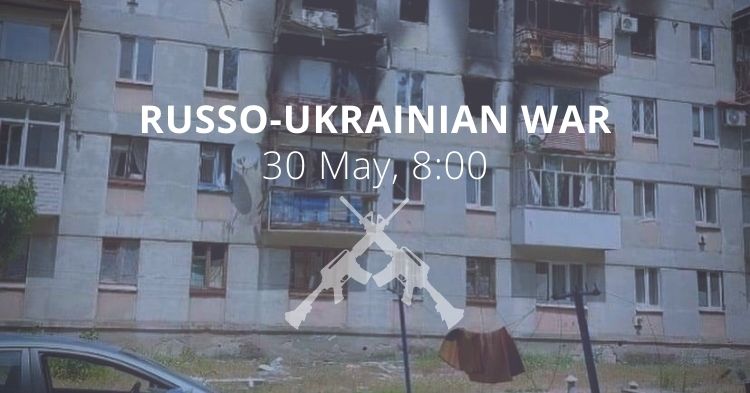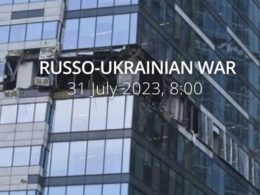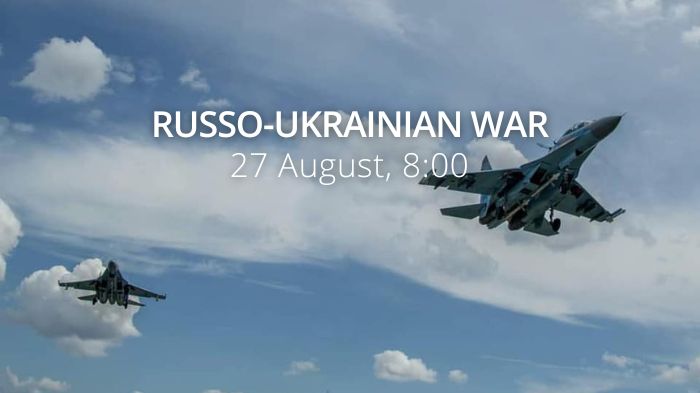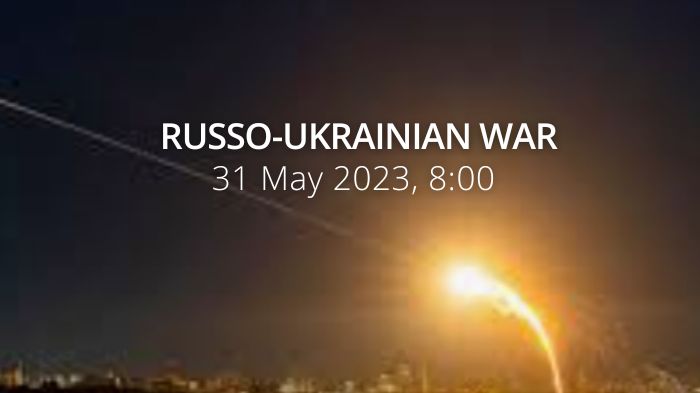Situation
A short overview of developments at the front as of the evening of 29 May 2022 according to military expert Roman Ponomarenko, and supplemented by morning information:
Russians shell the borders with Chernihiv and Sumy oblasts, fierce fighting continues in Luhansk Oblast.
Russia unsuccessfully tried to advance in the direction of Sloviansk. Despite yesterday’s evening announcement by the General Staff that fighting was ongoing in Lyman, it appears to be captured by Russia: according to the General Staff, Russians are reinforcing positions there.
https://twitter.com/ukraine_map/status/1531149522524688385
Street fights are ongoing in Sievierodonetsk. Russians are based in hotel Myr, and according to the General Staff, try to attack the city center. Fighting continues. To the south, Ukraine drove out Russians from Toshkivka. Yesterday, Luhansk Regional Head Serhiy Haidai announced that in the area of Komyshuvakha, Ukrainian forces had pushed away Russian forces from the Bakhmut-Lysychansk road, the crucial lifeline allowing to bring in humanitarian goods and reinforcements to Ukrainian troops. However, it is under Russian shelling. Ukraine holds positions in Zolote, surrounded on three sides.
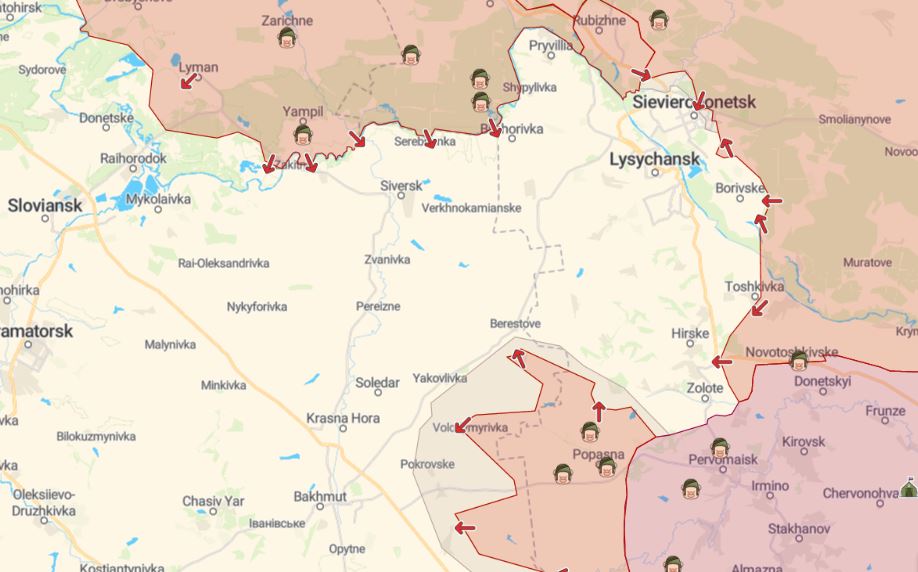
Sievierodonetsk (May 30 6:30 AM)
Fighting continues in Sievierodonetsk as Russian forces control a part in the East and a part in the North.
Ukrainian Forces still control 75-85% of Sievierodonetsk🇺🇦
Metolkino and Voronove are still contested villages.#UkraineWar #Ukraine #Luhansk pic.twitter.com/Cx2GLdKwxt
— Ukraine Battle Map (@ukraine_map) May 30, 2022
In the Bakhmut-Soledar sector, there are no significant changes, Russia shells Ukrainian positions but does not make attempts to advance. To the south, in Donetsk Oblast, Russian offensives near Avdiivka and Kurakhovo stopped.
Counteroffensive in Kherson Oblast – in the morning of 29 May, the General Staff reported that Russia “suffered losses as a result of offensive actions of Ukrainian units and took up the defense on unfavorable borders in the area of Kostromka.” This town lies west of Bruskynske; thus, Ukrainian troops broke 9km into Russian defense lines. Nevertheless, it is too early to talk about the collapse of the Russians here. Russian generals are now actively maneuvering troops and equipment in the Kherson Oblast and their counterattacks may begin soon.
Updates:
🇺🇦 has carried out a counterattack to the Northeast of Kherson pushing 🇷🇺 units to Bruskyns’ke and Kostromka. pic.twitter.com/FVUPQ5fRLJ
— Ukraine War Map (@War_Mapper) May 30, 2022
In general, the Russian offensive continues to slow down. Even in Luhansk Oblast, where they have concentrated a lot of capable troops and equipment, Russia does not succeed in defeating Ukrainian troops and achieving significant success. In this sense, it is interesting that analysts at the American Institute for War Studies noted that Putin is throwing more and more troops into Sievierodonetsk, believing that its capture “will affect the outcome of the war.” It is somewhat reminiscent of the Normandy campaign of 1944, when the Germans skillfully defended themselves against the dominant Allied armada. Most likely, the main task of the Ukrainian Army is to win more time from Russia and at the same time inflict as many losses as possible. And the possible fall of Sievierodonetsk will not be a catastrophe, the Russians will simply win another media victory, paying a considerable price.
But we should steer clear of overoptimism. Despite Ukrainian successes, the threat of the encirclement of the Ukrainian Army along the line Zolote – Toshkivka – Lysychansk – Sievierodonetsk remains.
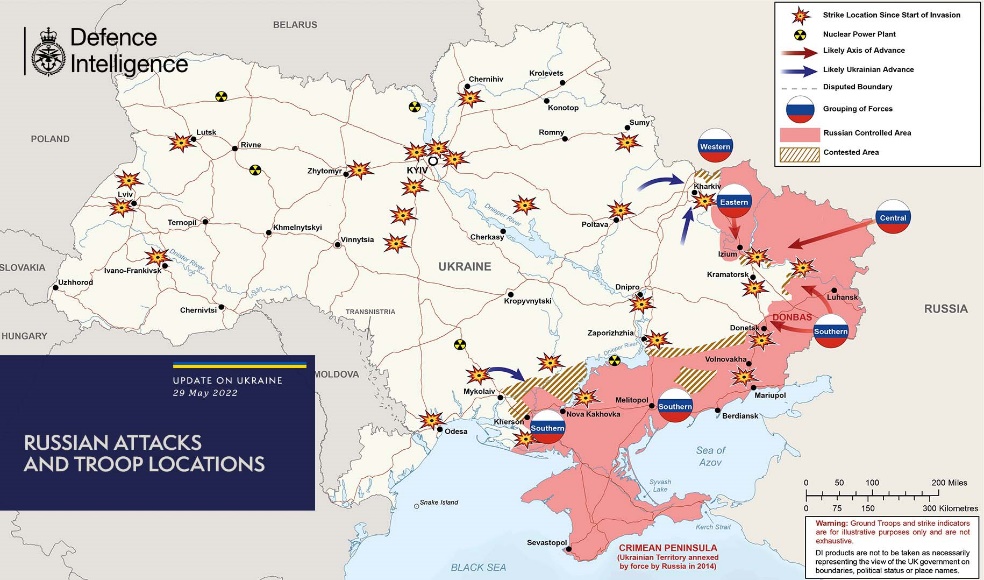
According to information from the General Staff as of 06.00 30.05.2022, supplemented by its [18:00 assessment] (read via the dropdown menu below)
Quote. “[Russian forces do not stop conducting offensive operations in the Eastern Operational Zone in order to establish full control over the territory of the Donetsk and Luhansk regions and block Ukraine’s maritime communications in the northwestern part of the Black Sea.]
In the Volyn and Polissya directions, there are no significant changes.
In the Siversky direction, Russian forces launched airstrikes on objects in the Sumy oblast in the areas of the settlements of Zapsillya, Myropillya, and artillery shelling near Kindrativka. [Russian forces continue to hold units of the 1st Tank Army of the Western Military District and airborne troops on the Russian-Ukrainian border in the Bryansk and Kursk regions to prevent the transfer of our troops to other threatening areas.]
- [The aggressor continued shelling the border areas of Chernihiv and Sumy oblasts. In particular, the settlements of Senkivka, Hirsk, Hrinivka, Gasychivka of Chernihiv oblast and Bachivsk, Seredyna Buda, Boyaro-Lezhachi, Manukhivka of Sumy oblast.]
- [To clarify the position of our troops, the enemy conducted air reconnaissance using UAVs.]
[In the Slobozhansky direction, Russian forces focused their main efforts on maintaining their occupied positions.]
- In the Kharkiv direction, Russian forces fired on the areas north and northeast of the city of Kharkiv, as well as the settlements of Ruski Tyshky, Cherkasy Tyshky, Ruska Lozova, Pytomnyk, Borshchova, and Peremoha. [Yesterday, the Russian occupiers used MLRS and artillery. Conducted air reconnaissance. In addition, they launched an airstrike on the village of Prudyanka.]
- In the Sloviansk direction, the Russian forces regroup troops to resume the offensive in the directions Izium – Barvinkove, Izium – Sloviansk. [Yesterday, Russian forces, with the support of artillery, carried out assault operations in the direction of Pasika – Bogorodychne, had no success and retreated to previously occupied positions. He fired several artillery and mortar shells at the settlements of Velyka Komyshuvakha, Dovhenke, and Vernopillya.]
- Russian forces are holding the Ka-52 helicopter squadron ready for air support to units in the area north of the city of Izium.
- As part of the logistical support and replenishment of the units that suffered casualties, Russian forces moved more than 250 weapons and military equipment to the temporarily occupied settlements. In order to increase the efficiency of the transfer of troops and equipment, the enemy rebuilt the railway bridge near the city of Kupiansk.
In the Donetsk direction, Russian aggressor’s units are focusing on offensive operations to surround our troops in the Lysychansk and Sievierodonetsk districts and to block the main logistics routes. [Russian occupiers waged active hostilities in the Sievierodonetsk, Bakhmut, and Kurakhiv areas.]
- In the Lyman direction, Russian forces are consolidating in the settlement of Lyman, regrouping for a further attack on Sloviansk. [Yesterday, some Russian units were withdrawn from the Lyman settlement.]
- In the Sievierodonetsk direction, the enemy is fixed on the northeastern and southeastern outskirts of Sievierodonetsk. To strengthen the group of troops, it transferred ammunition and equipment from the territory of the Russian Federation to certain areas. [Russian forces continue to fire on our troops with the use of artillery and MLRS. Yesterday, the enemy launched airstrikes by operational and tactical aircraft in the area of the village of Ustynivka. It is trying to gain a foothold on the northeastern outskirts of the city of Sievierodonetsk, conducting assault operations in the direction of the city centre.]
- In the Bakhmut direction, Russian occupiers are regrouping for a further offensive in the direction of Oleksandropillia – Komyshuvakha. [Yesterday, the enemy fired mortars, artillery shells, and multiple rocket launchers in the areas of the settlements of Komyshuvakha, Dolomitne, and Niu York. Inflicted an airstrike by operational and tactical aircraft in the areas of Berestove and Pokrovske. It fired four missiles at the settlements of Verkhnekamianske, Vrubivka and Soledar.]
- Russian forces did not wage active hostilities in the Kurakhiv and Novopavliv directions. Carries out fire damage to our troops, in particular, uses operational-tactical and army aircraft.
- [In the Avdiivka and Kurakhiv directions, Russian forces fired intensively at the positions of our troops, inflicting airstrikes with operational-tactical planes and helicopters.]
- In the Zaporizhzhia direction, Russian occupiers strengthened the group by moving up to 120 weapons and military equipment from the Melitopol area in the direction of Vasylivka.
- [Russian forces are actively using aircraft, missile forces, artillery, and electronic warfare. In order to make regular attempts to force the Siversky Donets River in certain areas, it replenishes ammunition and fuel and oil.]
- Over the past 24hrs, fourteen enemy attacks have been repulsed in the Donetsk and Luhansk directions, two artillery systems, eleven units of armoured combat vehicles and ten enemy vehicles have been destroyed. Air Defense units shot down two cruise missiles and three Cube-type UAVs.
In the Pivdennyy Buh direction, Russian forces continue to focus their efforts on maintaining the occupied borders, restraining the actions of our troops and preventing the transfer of the Defense Forces’ reserves to other areas.
- To replenish the losses of the group of troops, Russian occupiers are moving withdrawn military equipment from the territory of the Russian Federation and the temporarily occupied Crimea.
- [In the Mykolayiv direction, the aggressors carry out the movement of reserves for restoration of the lost positions in areas of the settlements Andriyivka, Belohorka and Bila Krynytsia. In the area of Stara Bohdanovka, the enemy used a strike UAV.]
- In the Kryvyi Rih direction, Russian forces continue artillery shelling of the positions of our troops and are conducting a counter-battery fight. [Yesteday, the occupiers fired at our troops with mortars, MLRS and artillery in the areas of Trudolyubivka, Mala Shesternya, Dobryanka, Knyazivka, Tokareve, Shyroke, Pervomaiske, Novomykolaivka, Kotlyarevo, Novohryhoriivske, Tavrykivske, Posad_Pokrovske.]
[In the waters of the Black Sea and the Sea of Azov, ships of the Black Sea Fleet of the Russian Federation continue to perform tasks to isolate the combat area. Russian forces are also blocking civilian shipping in the northwestern part of the Black Sea.]
Fighters of the Air Force shot down two enemy UAVs over the Sumy region the day before.
Armed Forces of Ukraine push Russian troops back from the Lysychansk-Bakhmut main road, the Ukrainska Pravda reported Sunday. “Serhii Haidai, Head of Luhansk Oblast Military Administration, said that reinforcements have arrived at the front line, enabling the Ukrainian Armed Forces to repulse the Russian troops from the main supply route between Lysychansk and Bakhmut. The road can once again be used to deliver humanitarian supplies.”
Ukrainian Armed Forces mount a successful counterattack in southern Kryvyi Rih, the Ukrainska Pravda reports. “… the situation on our Kryvyi Rih front line remains tense but stable and controlled… A successful counterattack was carried out south of Kryvyi Rih. 63 occupiers were killed and 19 units of enemy equipment destroyed, including modern T-72 tanks, a Grad multiple rocket launcher, artillery, helicopters, and one SU-35 aircraft, Oleksandr Vilkul, Head of Kryvyi Rih Oblast State Administration said.
Ukraine conducted a successful counterattack south of Kryvyi Rih – RegHead Oleksandr Vilkul
Says 63 Russian troops and 19 units of equipment were destroyed, including modern T-72 tanks, Grads, artillery, helicopters and one SU-35 aircrafthttps://t.co/GHlp9otZeV pic.twitter.com/9sI6JiYg1U
— Euromaidan Press (@EuromaidanPress) May 29, 2022
Security Service of Ukraine: contract soldiers in the Russian army are waiting for the end of May to escape from Ukraine, the Ukrainska Pravda reports. “At the end of May, the 90-day deadline set by the Putin regime for conducting the so-called “special operation” expires. Contract soldiers who came to fight in Ukraine in February are “legally” entitled to leave the service”.
The promise of rotation is the only incentive for Russians to fight, the Ukrinform reports. This was stated by a Battalion Commander with the 95th Separate Assault Brigade, Hero of Ukraine Major Yevhen Shamataliuk, who is now leading his troops in the Izium direction.
“I can’t even count the number of units storming our positions because they are constantly changing. They go on the offensive, we repulse it, respectively, the enemy withdraws, and then they rotate … And then again, and again … After their failed attempts, they either desert, refuse to obey orders, or get deployed somewhere in the rear for re-staffing and so on, said Shamataliuk.
According to the commander, various Russian units fought against his battalion. I know that there were airborne units, infantry, marines, and some were even freshly graduated rookies. There are a lot of documents that we have forwarded to the higher headquarters, where there are numbers of military units, names, lists, call signs, and so on. Some POWs told which units they were with, the major said.
He added that, according to those POWs, their commanders, while assigning them to missions, say as follows: If you take this settlement, you will be rotated tomorrow and you will return to Russia. Their soldiers are so demoralized that this is the only way to make them fight. They are terrified of artillery. Now we have more of that so we constantly inflict fire damage. They say they suffer significant losses. But the enemy is actively rotating and pulling up reserves.”
Ukraine is training local paramilitary units, the Ukrainska Pravda reports. According to Maksym Kozytskyi, the head of the Lviv Oblast Military Administration, 83 paramilitary units from the local communities have been formed in Lviv Oblast alone, including the city of Lviv. They are made up of thousands of citizens. The participants are being introduced to procedures for the transportation, deployment and use of heavy weapons. In particular, [they will learn to use] portable missile systems, grenade launchers and mortars. The Lviv Oblast Military Administration plans to expand the number of measures to train local volunteer paramilitary units this summer. Ukraine has 24 oblasts, of which 4 are partially occupied. Partisan activities have been reported in some of the latter.
According to British Defence Intelligence, (last 24 hours):
- Russia has likely suffered devastating losses amongst its mid and junior-ranking officers in the conflict. Brigade and battalion commanders likely deploy forwards into harm’s way because they are held to an uncompromising level of responsibility for their units’ performance. Similarly, junior officers have had to lead the lowest level tactical actions, as the army lacks the cadre of highly trained and empowered non-commissioned officers (NCOs) who fulfil that role in Western forces.
- The loss of large proportion of the younger generation of professional officers will likely exacerbate its ongoing problems in modernising its approach to command and control. More immediately, battalion tactical groups (BTGs) which are being reconstituted in Ukraine from survivors of multiple units are likely to be less effective due to a lack of junior leaders.
- With multiple credible reports of localised mutinies amongst Russia’s forces in Ukraine, a lack of experienced and credible platoon and company commanders is likely to result in a further decrease in morale and continued poor discipline.
As of Monday 30 May, the approximate losses of weapons and military equipment of the Russian Armed Forces from the beginning of the war to the present day:
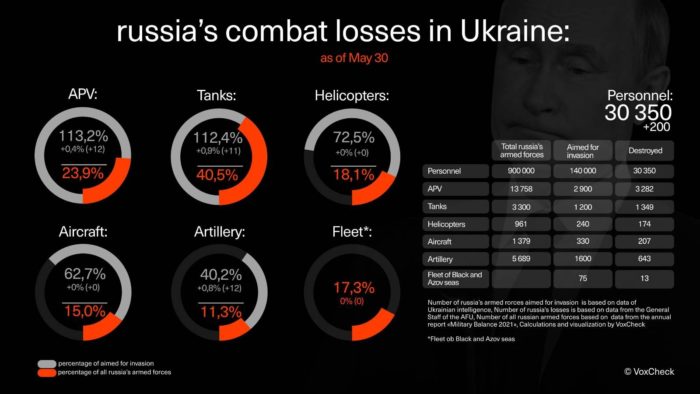
- Personnel – more than 30350 (+200),
- Tanks – 1349 (+11),
- Armoured combat vehicles – 3282 (+12),
- Artillery systems – 643 (+12),
- Multiple rocket launchers –MLRS – 205 (+2),
- Air defence means – 93 (+0),
- Aircraft – 207 (+1),
- Helicopters – 174 (+0),
- Automotive technology and fuel tanks – 2258 (+18),
- Vessels/boats – 13 (+0),
- UAV operational and tactical level – 507 (+3),
- Special equipment – 48 (+0).
- Mobile SRBM system – 4 (+0),
- Cruise missiles – 118 (+2)
Humanitarian
According to UNHCR 6,737,208 refugees have been registered as of May 27 (no update). The UN says that so far Poland has taken in 3,581,612 refugees, Romania 989,357, Russian Federation 971,417, Hungary 671,463, Republic of Moldova 477,637, Slovakia 454,961 and Belarus 29,547. Among those who fled Ukraine are also Ukrainian nationals with dual citizenship. An additional 105,000 people moved to the Russian Federation from the Donetsk and Luhansk regions between 18 and 23 February.
OHCHR recorded 8,766 civilian casualties in Ukraine as of May 27. 4,031 were killed (including 261 children) and 4,735 injured (including 406 children).
Environmental
The Race Against Food Inflation Starts on Rusty Soviet Railway Lines, Bloomberg reports.
The labyrinthine challenge has politicians looking at everything from naval escorts to shifting whatever’s possible overland to the Baltic. Officials at ports, logistics companies and in the agriculture industry interviewed across the region say they are scouring maps for solutions like diverting road transport and reviving rail links such as the one connecting Galati.
The task is complicated by a dearth of truck drivers and the fact that the Soviets used a wider track gauge than the European standard. That has caused up to 30 days of delays at borders for existing routes, the EU has said, as cargo needs to be transferred onto compatible rolling stock and customs infrastructure gets overwhelmed.
Ports in Romania and Poland, meanwhile, are backed up with traffic or already at capacity while there are shortages of specialized personnel to handle the surge in demand. Even with Ukrainian exports at a fraction of what they were, trade officials warn that bottlenecks will get worse as the rest of Europe starts harvesting its wheat next month.
“The scale of the problem is enormous,” Taras Kachka, Ukraine’s deputy minister of economic development, told a conference this month. “In the last 15 years, we developed our infrastructure in a way that it cannot be simply replaced by another destination, another port.” […]
Any increase in supplies is critical after the war in Ukraine sparked growing fears of a food crisis. At the World Economic Forum in Davos, Von der Leyen accused President Vladimir Putin of using “hunger and grain to wield power” as she decried Russia’s bombing of grain warehouses and blockading of Ukrainian ships filled with wheat in the Black Sea. About three-quarters of Ukrainian harvests are typically sold abroad, and it’s a key exporter to Africa, Asia and the Middle East as well as Europe.
Ukraine’s agriculture minister expects another 30 to 40 million tons of grain will need to be exported after harvests this summer and fall. While grain can be stored, farmers need to sell it to get funds for planting 2023 supplies, with winter-crops like wheat sown in just a few months. […]
“Alternatives to Odesa simply don’t exist to send the amounts of grain that Ukraine has accumulated and will accumulate over the summer,” Gabrielius Landsbergis said on May 26. We either need to accept that grain will be rotting, a part of the world will face food shortages, prices will rise, or we need to find ways how to unblock Odesa.”
Legal
An ‘unprecedented’ effort to document war crimes in Ukraine. But what chance of justice, The Washington Post asks?
Poland is one of 18 countries that have started their own criminal investigations into war crimes in Ukraine, according to Ukraine’s prosecutor general, Iryna Venediktova. In the United States, where the State Department has asserted that war crimes have been committed by Russian troops in Ukraine, officials have said Washington could tap into its huge intelligence apparatus to assist investigations.
All together, it amounts to an unprecedented endeavor, experts say, and it’s happening in real-time. In no other conflict has there been such a concerted push to lay the groundwork for potential war-crimes trials from the start, said Philippe Sands, a law professor at University College London who was involved in the case against Gen. Augusto Pinochet, the Chilean dictator. […]
Still, experts say whether any high-level officials end up in court could depend in large part on the political situation in Russia. While the two former German ministers concede that the chances of Russian perpetrators ending up in Germany are unlikely, they said they hope international warrants might act as a deterrent on the battlefield.
Others disagree. I don’t think that’s the logic the Russians operate on, said Andreas Schüller, head of the International Crimes and Accountability Program at the European Center for Constitutional and Human Rights. Since international sanctions have already restricted where Russian officials can go, international warrants, for now at least, would be symbolic to an extent.”
 243 children were killed, and 444 children injured, the Office of the Prosecutor General of Ukraine reports as of May 30. 1,888 educational establishments are damaged as a result of shelling and bombings, 180 of them are destroyed fully. 14,594 crimes of aggression and war crimes and 6,871 crimes against national security were registered.
243 children were killed, and 444 children injured, the Office of the Prosecutor General of Ukraine reports as of May 30. 1,888 educational establishments are damaged as a result of shelling and bombings, 180 of them are destroyed fully. 14,594 crimes of aggression and war crimes and 6,871 crimes against national security were registered.
Support
Ukrainian Presidential Office: Russians hysterical after US shipment of MLRS systems to Ukraine, Ukrainska Pravda reports. “They enter the territory of another country and destroy infrastructure on a large scale, massacre civilians, and deliberately demolish all our cities. They call it a disgusting and false term: ‘special military operation’. All types of heavy artillery, heavy flamethrowers, rocket-propelled grenade launchers, heavy aircraft bombs, and cruise missiles of various modifications with a range of over 1000 km are used in Ukraine. But as soon as it became known that Ukraine would still receive MLRS with a normal range (100+ km), the Russians immediately fell into hysterical hysteria”, Mykhailo Podoliak, adviser to the President of the Ukrainian President’s Office, pointed out and called on the West not to hesitate going forward and continue to put pressure on Russia.
Ukraine suffers on the battlefield while pleading for US arms, The Washington Post reports.
If he could send one message to Washington, he said, it would be this: “Help us with weapons. The most important is antiaircraft. Close the sky — it’s the civilians who are suffering the most.”
The situation in the country’s east marks a shift from an earlier stage of the war, when staunch Ukrainian defences forced a broad Russian retreat in Kyiv and other areas, increasing confidence among Ukrainians and their Western backers about the prospects of all-out victory over a poorly organized and equipped Russian force.
Having now regrouped, Russian troops are making incremental but steady progress in their campaign in the east and are regularly employing heavy flamethrowers and long-range artillery that Ukrainian forces lack, leaving Kyiv on the back foot. Though Ukrainian resistance has made the fight a slog for Russian forces, Moscow is inching closer to encircling Ukraine’s biggest strongholds in the Donbas region, while fighting on territory contiguous to Russia with easier supply lines. […]
For weeks, Zelensky and other top Ukrainian officials have been asking the United States to provide multiple launch rocket systems, or MLRS, which would give Kyiv the ability to strike targets from much farther away and a better chance of resisting the assault in the east.
US officials and congressional staffers told The Post on Friday that the administration is preparing to send the weaponry and could announce the move as early as this week, but the White House must still make a final decision on the transfer. Whether the weaponry will get to Ukrainian forces in time to stave off a significant defeat in the east is now unclear, as Russian forces unleash a wave of attacks with gruesome weaponry on Ukrainian positions, forcing an exodus of people from the country’s embattled easternmost regions.
In an Instagram post on Friday, Andriy Yermak, head of the Ukrainian presidential administration, said Ukrainian forces needed the weaponry “yesterday,” as well as other systems that have been requested, such as air defense systems and tanks.”
Ukrainian Ministry of Defence calls for patience with weapons supply, the Ukrainska Pravda reports. “Weapons supply is a lengthy process. It is very different from how you would go about buying something in a shop or even from buying something abroad and bringing it back in, which can take as little as a day. And so in this situation, we must be patient and understand that practically all agreements have been concluded; we have an understanding of the rate at which the arms will be supplied and the time frame of this process, but we still need time to reach combat parity, Hanna Maliar, Deputy Defence Minister of Ukraine, said.”
Lithuanians raise $5.4 million to buy a drone for Ukraine, Reuters reports. Hundreds of Lithuanians clubbed together to buy an advanced military drone for Ukraine in its war against Russia, in a show of solidarity with a fellow country formerly under Moscow’s rule. The target of five million euros ($5.4 million) was raised in just three and a half days, largely in small amounts, to fund the purchase of a Byraktar TB2 military drone, according to Laisves TV, the Lithuanian internet broadcaster that launched the drive.
EU to pledge support for Ukraine, but not ready with new Russia sanctions, Reuters reports. “European Union leaders will meet on Monday to declare continued support for Ukraine to help it fend off Russia’s assault, but the talks will be overshadowed by their failure to agree on a new sanctions package against Moscow. […] Draft conclusions of the meeting, seen by Reuters, showed that while the EU will be generous with verbal support for the government in Kyiv, there will be little in terms of new decisions on any of the main topics.
“After Russia’s attack on Ukraine, we saw what can happen when Europe stands united. With a view to the summit tomorrow, let’s hope it continues like this. But it is already starting to crumble and crumble again,” German Economy Minister Robert Habeck said on Sunday. The most tangible will be the leaders’ political backing for a 9 billion euro package of EU loans, with a small grants component to cover part of the interest, so that Ukraine can keep its government going and pay wages for around two months. But even there, the decision will be only made later, after the European Commission makes a proposal on how to raise the money.
Despite efforts since the start of May, EU governments cannot agree on the sixth package of sanctions against Moscow because one of the elements – an embargo on buying Russian oil – is not acceptable to Hungary and is a big problem for Slovakia and the Czech Republic. […]
The draft summit conclusions showed EU leaders will back the creation of an international fund to rebuild Ukraine after the war, with no details, and want to look into the possibility of confiscating frozen Russian assets for that purpose. But the careful phrasing is deliberate because the issue is legally difficult, officials said. The leaders will pledge to accelerate work to help Ukraine move its grain out of the country to global buyers via rail and truck as the Russian navy is blocking the usual sea routes and to take steps to faster become independent of Russian energy.
New developments
- The enemy should realize that Ukrainians will defend their land to the last – President Zelensky, Ukrinform reports. “In this war, the occupiers are trying to squeeze at least some result for themselves. But, they should have long realized that we will defend our land to the last. They have no chance. We will fight and definitely win,” President Zelensky wrote on Facebook.
- Donbas is an ‘unconditional priority for Russia, Lavrov says, Reuters reports. “The “liberation” of Ukraine’s Donbas region is an “unconditional priority” for Moscow, while other Ukrainian territories should decide their future on their own, Russian Foreign Minister Sergei Lavrov said on Sunday.”
- Scholz: “Putin will not win“, Ukrayiska Pravda reports citing Ukrinform. According to German Chancellor Olaf Scholz, Russian President Vladimir Putin will not win the war against Ukraine. Scholz noted that Germany, together with friends and partners, is helping to prevent the Ukrainian economy from collapsing, sending weapons to help Ukrainians defend themselves.
- Russia won’t use tactical nuclear weapons in Ukraine, says ambassador to the UK, BBC reports. “Russia’s ambassador to Britain has told the BBC he does not believe his country will use tactical nuclear weapons in the war against Ukraine. Andrei Kelin said that according to Russian military rules, such weapons are not used in conflicts like this.”
- Erdogan says he won’t let ‘terrorist-supporting’ countries enter NATO, Reuters reports. “Turkish President Tayyip Erdogan said talks with Finland and Sweden about their joining NATO were not at the “expected level” and Ankara cannot say yes to “terrorism-supporting” countries, state broadcaster TRT Haber reported on Sunday.”
Assessment
1. On the War

The Institute for the Study of War has made the following assessment as of Sunday 29 May:
Russian forces continued to assault Sievierodonetsk on May 29 but did not make any confirmed advances; Russian progress in intense urban combat will likely be slow. The Russian campaign in eastern Ukraine—which previously aimed to capture the entirety of Luhansk and Donetsk Oblasts—is now focused almost entirely on Sievierodonetsk. Russian troops are unlikely to be able to conduct multiple simultaneous operations and will likely further deprioritize advances southeast of Izium and west of Lyman in favor of concentrating available forces on Sievierodonetsk in the coming days.
https://twitter.com/EuromaidanPress/status/1531193697030873088
Key Takeaways
- Russian forces continued attempts to take full control of Sievierodonetsk.
- Russian forces continued offensives southeast of Izium but did not make any confirmed advances toward Sloviansk.
- Russian forces continued offensive operations to cut Ukrainian ground lines of communication (GLOCs) northeast of Bakhmut and appear unlikely to attempt to directly assault the city.
- The Ukrainian counteroffensive in northwestern Kherson Oblast has forced Russian troops to take up defensive positions and will likely disrupt Russian efforts to effectively dig in and consolidate control of occupied areas along the Southern Axis.“
Drones. Crutches. Potatoes. Russians Crowdfund Their Army, The New York Times reports. “Across Russia, grass-roots movements, led in large part by women, have sprung up to crowdsource aid for Russian soldiers. They are evidence of some public backing for President Vladimir V. Putin’s war effort — but also of the growing recognition among Russians that their military, vaunted before the invasion as a world-class fighting force, turned out to be woefully underprepared for a major conflict. […]
Medical gear is in high demand in part because of the growing firepower of Ukraine’s military as the West increasingly fortifies it with powerful weapons. Aleksandr Borodai, a separatist commander and a member of the Russian Parliament, said in a phone interview that materials to treat shrapnel wounds and burns were needed in great quantities on the Russian side of the front. More than 90 percent of Russian injuries in some areas, he said, have recently been caused by artillery fire.
Mr. Borodai said that his units had noted the use of 155-millimeter shells fired by American howitzers, and that Russia’s leadership may have underestimated the determination of the West to support Ukraine. It’s not making the military operation go any faster from our point of view — it’s making our situation more difficult, I don’t deny it, Mr. Borodai said, referring to Western weapons deliveries. It’s possible that our military leaders were not ready for there to be such massive support on the part of the West. […]
Spporters of the war are pointing to private donations as a key to victory. Pro-Russian military bloggers, some of them embedded with Russian troops, are urging their followers to donate money to buy night vision equipment and basic drones. Our guys are dying because they lack this equipment, one blogger wrote, while the entire West is supplying the Ukrainian side. The needed equipment, largely imported, can be bought at Russian sporting goods stores or ordered online. Starshe Eddy, a popular military blogger, wrote that consumer drones made by the giant Chinese company DJI have become so firmly entrenched in combat operations that it’s become hard to imagine the war without them.”
2. Consequences and what to do?
Hans Petter Midttun’s assessment: The EU leaders are this week expected to pledge to accelerate work to help Ukraine move its grain out of Ukraine to global buyers via rail and truck as the Russian navy is blocking the usual sea routes.
If that becomes the final result of the special European Council meeting on 30 and 31 May, the EU is losing momentum at a critical juncture of the war. Its efforts to counter the Russian war on the European continent stumble as the direct costs and risks for its member states increase.
Rail and road do not substitute maritime transport. It has already been established that transport over the Black Sea ports is the only realistic manner to move the massive volume of grain. Transport over land is limited by several factors, including the lack of train wagons, Ukrainian freight wagons using a wider rail gauge than its neighbors, and the lack of both fuel and trucks. It will take years and billions of dollars to overcome, these obstacles.
The focus on rail and road deflects the EU from tackling the two crucial challenges at hand.
- Firstly, it avoids taking the measures needed to avoid the looming food and hunger crisis from happening.
- Secondly, and equally important, it is a surrender to the Russian claim over international waters in the Black Sea and a failure to protect Freedom of Navigation.
According to David F. Lasseter, former Deputy Assistant Secretary of Defense,
“by undermining the rules-based international order, these illegitimate assertions of authority, born out of patent self-interest, are a danger to international peace and security. As part of the rules-based order that has benefited all nations since World War II, the 1982 UN Convention on the Law of the Sea (UNCLOS) strikes a deliberate balance between maritime control by coastal states, on the one hand, and navigational freedoms for all, on the other. From a defence perspective, this balance decreases the risk of military miscalculation, but it also promotes cooperation in other areas, like law enforcement, scientific exploration, and commercial development. When a nation asserts an excessive maritime claim that upsets this balance, it promotes instability, which has negative economic and security implications for the entire international community, including land-locked nations. Acquiescence to these unlawful, excessive maritime claims could, over time, erode the law and permanently infringe on all nations’ navigational rights and freedoms.”
The EU and the international community urgently need to establish a Freedom of Navigation Operation in the Black Sea, supported by the need for a Humanitarian Intervention on behalf of all suffering from food insecurity.
Failure on both accounts has far-reaching consequences. One will lead to massive starvation and death. The other will set the global Freedom of Navigation at risk as both China and Russia are trying to impose restrictions in areas crucial to international trade (e.g. the Arctic and the South-China Sea) while both the EU and NATO succumb to its policy of risk and casualty aversion.

